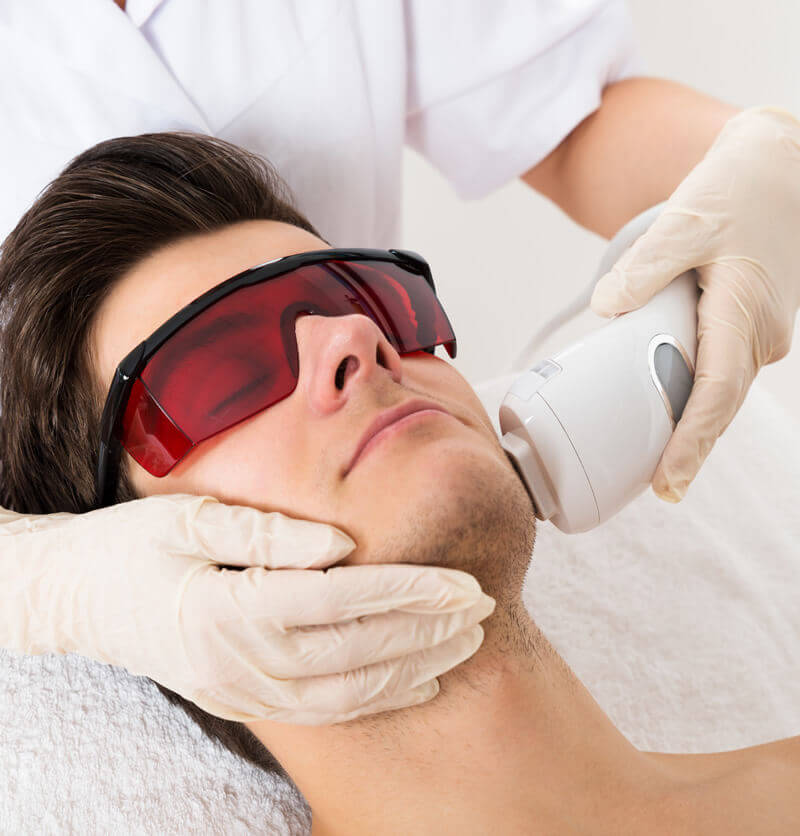Shedding light
Even during COVID-19, non-surgical cosmetic procedures such as laser hair removal remain in high demand. While it has been commercially available for about 25-years, technology advances continue to make laser hair removal a very desirable procedure today, as potential candidates for this treatment has diversified. In fact, according to the website “American Society of Plastic Surgeons” as of 2019, it remains in the top five non-surgical cosmetic procedures, along with Botox and similar-type injections, dermal fillers, chemical peels, and microdermabrasion.
WHY IS LASER HAIR REMOVAL POPULAR?
While waxing remains a popular service, laser hair removal has grown immensely in popularity over the past 10 to 15 years for several reasons. The first reason being that clients love that lasers are effective and offer longer-lasting results than either waxing or shaving. Lasers provide comfortable treatments and offer flexibility and personal preference options. An example of this would be that clients may only get laser hair removal in areas where they prefer permanent hair reduction and maintain waxing in other areas. Lastly, treatments are more affordable now than ever before – that was not the case 20-years ago.
“Laser hair reduction can be done on anyone, including all ethnicities. The clients who will reach their end or desired result the fastest are typically light ethnicities with black or dark hair; they will also require fewer treatments. The darker the ethnicity, the more treatments will likely be required, still reaching the desired result.”
HOW DO LASERS WORK?
There are many different wave-lengths or depths of lasers. Depend-ing on the wavelength, a laser must have a target (chromophore) to get a reaction (a result). The laser is energy that converts to thermal heat and is absorbed by the chromophore. The four main chromophores that absorb thermal heat are blood, melanin, water, and ink (tattoos). To accurately and effectively be absorbed, a laser wavelength must be at the proper depth within the skin; when the target or chromophore absorbs the heat, the desired result is then achieved.

WHAT IS THEDIFFERENCE BETWEEN LASERS & INTENSE PULSE LIGHT?
Sometimes clients use the terms laser and IPL interchangeably. They work in different ways, so it is important for a skin care professional to know the distinction. There are two ways to remove hair with thermal heat – lasers and intense pulsed light (IPL). Lasers may be used on all ethnic skin types, with different wavelengths appropriate for the ethnicity. IPL, on the other hand, may be used only on lighter ethnicities.
Laser is a direct beam while IPL is scattered light and more superficial in the skin. Hair is the chromophore of melanin, so this is where ethnici-ties are very important to determine which modality would be best for a particular client. The desired result is to destroy the hair follicle while sparing the surrounding skin. With IPL, every wavelength targets melanin; therefore, it is risky to treat darker ethnicities. With laser, there are wavelengths that avoid superficial melanin and are deep enough in the skin to destroy the bulb or root of the hair without damaging the skin. Both are effective for permanent hair reduction, with IPL having these limitations. It is important to note that permanent laser hair is reduction rather than laser hair removal, as no modality can accurately claim to per-manently remove all unwanted hair.
WHEN IS THE BEST TIME TO PERFORM TREATMENTS?
When giving or receiving laser hair reduction treatments, it is im-portant to schedule appointments in the anagen (growing phase). Hair grows in three different phases, at different rates, and on different parts of the body. The anagen phase is the longest phase, which makes treatment scheduling very convenient. After a time, it begins transitioning to a slowing down in the growth process – this is called the catagen phase, and it is the shortest phase. Finally, there is the telogen phase. This is the resting or dormant phase which lasts around three months before the process begins again. All hair does not grow simultaneously in the same phases. For example, the hair on the face and scalp grows in faster phases than other parts of the body. Also, not every follicle in a particular area is in the same phase at the same time, therefore, preventing areas of “no hair” simultaneously.
RECENT ADVANCES IN TECHNOLOGY & PRICING
Technological advances in laser hair reduction have improved greatly in recent years, especially when it comes to comfort. Older lasers did not have the cooling mechanisms that newer versions have. Unfortunately, because older lasers were quite painful, it often prevented clients from completing their treatment packages (meaning, the number of treatments needed to achieve the end desired result). Today’s lasers are faster, more comfortable, and more affordable due to increased competition in the marketplace.
CAN ANYONE GET LASER HAIR REDUCTION?
Laser hair reduction can be done on anyone, including all ethnicities. The clients who will reach their end or desired result the fastest are typi-cally light ethnicities with black or dark hair; they will also require fewer treatments. The darker the ethnic-ity, the more treatments will likely be required, still reaching the desired result. It is important to note that laser hair reduction will not be effec-tive on blonde, white, or gray hair as there is not enough pigment for the laser to target.

HOW MANY TREATMENTS ARE TYPICALLY REQUIRED?
For lighter ethnicities, anywhere from six to 10 treatments are expected, assuming the client stays on schedule during the hair growth phases. Darker ethnicities will typically require 10 treatments – possibly more, depending on the area being treated. Different areas are in the anagen phase, sometimes more or less, than another. Facial treatments are scheduled around four weeks apart; underarms, bikini, chest, and abdomen areas are scheduled around six weeks apart; and arms, legs, and back areas are typically scheduled around eight to 10 weeks apart. Appointments being scheduled will depend on whether the hair is in the anagen phase or not. The more treatments that are performed, the slower the hair will grow back then treatments may be scheduled further apart.
HOW SHOULD A PROFESSIONAL HANDLE A LASER BURN?
Even with every benefit that laser hair removal offers, there are some inherent risks. While it is generally a safe and effective procedure with few side effects, lasers are powerful devic-es and in the wrong hands can cause burns, hyperpigmentation, hypopig-mentation, and emotional scarring. Knowing how to handle laser injuries should never start at the time of the burn; ideally, it starts way ahead of time by properly educating both the laser technician and the client.
Formal laser training is crucial to anyone operating a laser device. Anyone can YouTube or Google “how-to use a laser” but that is a potentially very dangerous approach. First, the laser technician should possess a thorough understanding of the fundamentals of skin anatomy and laser safety. Additionally, it is important that they have had extensive practice on actual clients’ skin under strict supervision – before performing their first solo treatment. Second, the laser technician should be able to fully explain to the client that to minimize injury they should avoid sun exposure when getting hair removal treatments. Clients should avoid photosensitizing medications such as Accutane. Additionally, the body should not be exposed to heat for two days post-treatment, includ-ing hot tubs, steam room use, or strenuous exercise.
Sometimes, no matter how carefully a professional chooses the appropriate laser and performs a par-ticular treatment, a burn may occur. While the professional should be able to discuss any complications with the client and assess proper treatment (cool packs, antibacterial or moistur-izing salves, medical intervention, and so on.), perhaps one of the most important aspect of resolution is re-sponse time. Laser injuries can cause clients to become angry or upset. When the laser technician responds immediately to the client’s concerns it shows genuine compassion and con-cern, and that they are prepared to do whatever they can to make things right (or at least better). It goes a long way in the overall outcome.

WHO CAN BECOME A LASER TECHINICIAN?
A common misconception in the industry is that a person must have an aesthetician or beauty background to become a laser technician. Many aes-theticians do go on to receive cosmet-ic laser training so that they can add those skills to their menu offerings. Quite a few people do not realize that in most states, anyone can perform la-ser hair removal with proper training. These requirements vary by state, so it is always a good idea to check with individual state laser boards.
Cosmetic laser training schools vary in length and types of programs, but if considering attending, be sure to look for one that offers a compre-hensive program in both didactic (classroom) and hands-on training.
CHOOSING THE RIGHT PATH
Being a certified laser technician can exceed the expectations. Laser hair reduction is only the begin-ning – it is a doorway to improving anything and everything a client desires. Many clients start with laser hair removal because it is so popular and affordable. But, once a skin care professional starts telling them about all of the other services offered (like radio frequency for skin tightening, skin resurfacing treatments for acne scarring, reduction of fine lines and wrinkles, cryolipolysis for fat reduction, and more), clients will be interested in exploring laser treat-ments that lead to successful results. Laser hair removal can be used as a starting point to build a spa or skin care business.
Skin resurfacing lasers are incredible, and the advances in these treatments have come so far that clients are putting off invasive surgeries. The best part is being able to work in an environment that seeks to improve someone’s confidence in themselves. Clients’ self-esteem begins to soar following great results and can make a skin care professional’s job rewarding.
Whether considering laser hair removal as a career, the future for this modality is bright. Results speak for themselves, and most clients report a high satisfaction rate following the completion of their treatments. The fact that both women and men of all ages are seeking laser hair removal as a treatment to simplify their lives means that income potential in this particular field can be highly lucrative.
